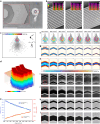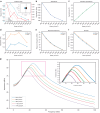Nanofabricated high turn-density spiral coils for on-chip electromagneto-optical conversion
- PMID: 38529010
- PMCID: PMC10961313
- DOI: 10.1038/s41378-024-00674-9
Nanofabricated high turn-density spiral coils for on-chip electromagneto-optical conversion
Abstract
Circuit-integrated electromagnets are fundamental building blocks for on-chip signal transduction, modulation, and tunability, with specific applications in environmental and biomedical micromagnetometry. A primary challenge for improving performance is pushing quality limitations while minimizing size and fabrication complexity and retaining spatial capabilities. Recent efforts have exploited highly involved three-dimensional synthesis, advanced insulation, and exotic material compositions. Here, we present a rapid nanofabrication process that employs electron beam dose control for high-turn-density diamond-embedded flat spiral coils; these coils achieve efficient on-chip electromagnetic-to-optical signal conversion. Our fabrication process relies on fast 12.3 s direct writing on standard poly(methyl methacrylate) as a basis for the metal lift-off process. Prototypes with 70 micrometer overall diameters and 49-470 nm interturn spacings with corresponding inductances of 12.3-12.8 nH are developed. We utilize optical micromagnetometry to demonstrate that magnetic field generation at the center of the structure effectively correlates with finite element modeling predictions. Further designs based on our process can be integrated with photolithography to broadly enable optical magnetic sensing and spin-based computation.
Keywords: Nanoscale devices; Sensors.
© The Author(s) 2024.
Conflict of interest statement
Conflict of interestThe authors declare no competing interests.
Figures






References
-
- Burghartz JN, Rejaei B. On the design of RF spiral inductors on silicon. IEEE Trans. Electron Devices. 2003;50:718–729. doi: 10.1109/TED.2003.810474. - DOI
-
- Alibakhshikenari M, et al. A comprehensive survey on antennas on-chip based on metamaterial, metasurface, and substrate integrated waveguide principles for millimeter-waves and terahertz integrated circuits and systems. IEEE Access. 2022;10:3668–3692. doi: 10.1109/ACCESS.2021.3140156. - DOI
-
- Nguyen, C. T.-C. Microelectromechanical devices for wireless communications. in Proceedings MEMS 98. IEEE. Eleventh Annual International Workshop on Micro Electro Mechanical Systems. An Investigation of Micro Structures, Sensors, Actuators, Machines and Systems (Cat. No. 98CH36176) 1–7. 10.1109/MEMSYS.1998.659719 (1998).
-
- O KK, et al. On-chip antennas in silicon ICs and their application. IEEE Trans. Electron Devices. 2005;52:1312–1323. doi: 10.1109/TED.2005.850668. - DOI
LinkOut - more resources
Full Text Sources
